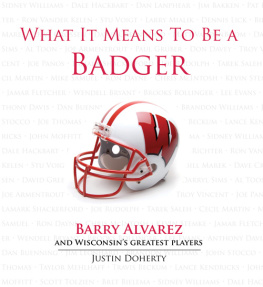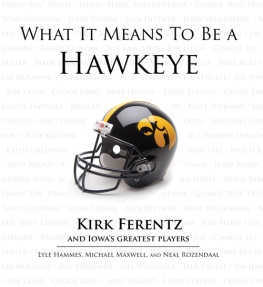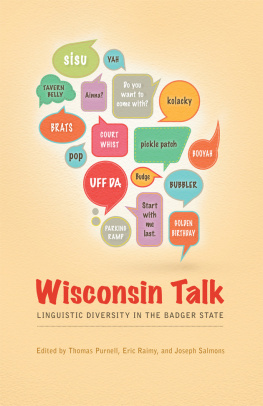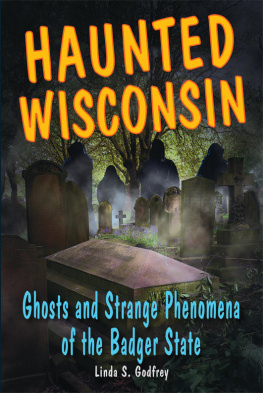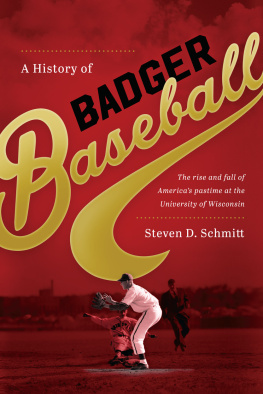Foreword by Barry Alvarez
What It Means to Be a Badger
A nyone who has ever been to Madison for a football game will tell you there is nothing like spending a Saturday at Camp Randall Stadium. The smells and sights and sounds of Badgers fans enjoying their tailgate parties. Everybody dressed in red and white from head to toe. A cool, crisp autumn day in the heart of Big Ten football country. It is flat-out special, and it has been this way at Wisconsin for decades.
Like any college football program, ours has journeyed through periods of triumph as well as adversity. The great 1942 team knocked off top-ranked Ohio State only to see several of the young men on its roster eventually head off to war, some never to return. There was the introduction in 1948 of Paul Bunyans Axe, to be awarded each year to the winner of our annual game with Minnesota. The Hard Rocks defense led the nation by allowing only 5.9 points per game in 1951. Alan Ameche became our first Heisman Trophy winner in 1954. There were Rose Bowl appearances in 1953, 1960, and 1963, the latter, of course, still being remembered as one of the great games of all-time with Ron Vander Kelen and Pat Richter starring in the Badgers near comeback victory over No. 1ranked USC.
The program struggled for a number of years in the 1960s, but things slowly began to turn around. Running backs like Rufus Ferguson and Billy Marek, and offensive linemen like Dennis Lick and Mike Webster helped to reestablish the great ground game that has become a signature of our program. Dave McClain took over as coach in the late 1970s and, eventually, guided Wisconsin to its first bowl appearances in some 20 years, with players like David Greenwood, Tim Krumrie, Al Toon, Matt VandenBoom, and many others. Coach McClain then passed away suddenly in 1986, and the program struggled once again.
I was hired by athletics director Pat Richter in 1990. In spite of the programs downturn in recent years, I felt Wisconsin football had potential, and I came in with a plan. I had been fortunate enough to play in a winning program at Nebraska and coach in winning programs at Iowa and Notre Dame. I knew it wasnt going to be easy, but I felt we could have success if we stuck with the plan I had and got the players to buy in. About 50 players left the program in my first year, but we were changing the culture. I wanted tough kids in the program, kids who were passionate and wanted to work hard and believed in what we were trying to accomplish. One of the guys in the program when I got to Wisconsin was Don Davey, a defensive lineman. Don was a senior in 1990, but he was someone I could hold up as an example to the younger players. He was tough, smart, and talented, and he could have started in any program in the country. I thought wed be all right if we could find some more Don Daveys. Eventually, we did.
Joe Panos, who transferred to Madison from UW-Whitewater, was tough as nails and as good a leader as Ive ever been around. He came to typify our program by the time we won the 1993 Big Ten title and the 1994 Rose Bowl. So did Ron Dayne, who came to us as a heralded freshman in 1996. Other schools thought he was too big to be a tailback. Four years, 7,125 yards, and a Heisman Trophy later, he proved himself to be the perfect size for a tailbacka Wisconsin tailback. Our Big Ten and Rose Bowl championship teams of the late 1990s were loaded with toughness, talent, and character. Thats a pretty tough combination to beat. Chris McIntosh, Mike Samuel, Donnel Thompson, Chris Ghidorzi, Jamar FletcherI could go on and on. Those teams were blessed with great leadership and focus.
We didnt win another conference championship during my time as head coach, but we sure had some great moments and victories and players. I think back to Brooks Bollinger leading us to an upset overtime win against Colorado in the 2002 Alamo Bowl; Lee Evans comeback from his knee injury to catch the winning touchdown pass against Ohio State in 2003; the great walk-on-to-All-American story of Jim Leonhard; the late fourth-quarter wins at Purdue in 2004 and Minnesota in 2005. And then, to top it all off and end my coaching career with the win over No. 7 Auburn in the Capital One Bowl on New Years Day in 2006, well, I couldnt have drawn it up any better.
Ive spent the past five years as an athletics director watching a young coach navigate his way through the rigors of college football in the Big Ten. Bret Bielema has proven himself to be one of the top coaches in the college game. In just five seasons, he has been a Big Ten Coach of the Year, coached a Big Ten championship team to the Rose Bowl, and accumulated a 4916 record. Id also add that Brets team last season had the highest fall grade-point average on record for a Badgers football squad. Last season was a memorable one in Wisconsin football history, and Bret has the program right where we all want it to be.
As I look at the history of the program and, in particular, the past 20 years that Ive been in Madison, something rings true to me. You cant run a successful football program or business or venture of any kind without quality people. They have to have talent, of course, but they also have to have character, passion, and a strong work ethic. Growing up in western Pennsylvania, we were taught to play physical, hard-nosed football. Field position and time of possession were important. Thats the way we played at Nebraska, as well. Its a recipe for success that I think has been a perfect fit at Wisconsin because work ethic and physical football are central to the type of game that is played around our state.
Youll notice something as you read the stories in this book. Regardless of when these former Badgers played50 years ago or last seasonthere are some common threads running through all of them. First, they love the University of Wisconsin. They met lifelong friends in Madison, on and off the field, and many of them will tell you their college years were the best of their lives. They also, to a man, loved the fans at Wisconsin. They appreciated your support. They also appreciated the opportunity to have been student-athletes at one of the worlds great universities and in the nations best conference.
Wisconsin has been a special place for my family and me. Most of the players Ive mentioned here have a good story to tell, and I know youll enjoy reading them in the following pages because Wisconsin has been a special place to so many former Badgers, as well.
Barry Alvarez
The Fifties
Sidney Williams
Quarterback
19561958
I was an only child and had an uncle who was about four years older than I am who used to buy lots of sports magazines. We would sit down and read through them together. I just sort of became a sports junkie. From that, I started playing football out in the streets. The streets were not paved where I lived, so we started there, then wed go down to a college field about two blocks from where I lived and started playing tackle football. I think around the sixth grade I organized a team called the West End Rinkidinks. We played the South End Bulldogs, the East End Eagles, the Gibbs Wildcats, and the Park Street Alleycats. No equipment or anything, but we scheduled games and we played.
A good friend of mine did have all the football equipment. He had helmets, he had footballs, he had his little football pants, so he started off as the quarterback. I cant remember exactly what position I was playing, but, at some point, it ended up that I became the quarterback. So I continued to play sandlot ball like that until about the ninth grade, and then our team organized a junior high school team, and I started playing there. So there was always that interest in football, basketball, and track. Thats really how it all got started. This was all in Little Rock, Arkansas. I started again reading various sports magazines, and, at that time, the Big Ten Conference was without a doubt the most powerful conference in the country, so I decided that I wanted to play in the Big Ten. I did fairly well in high school and ended up getting a scholarship.
Next page
